Special Feature: Products Sally Recommends
Impressions of Istanbul
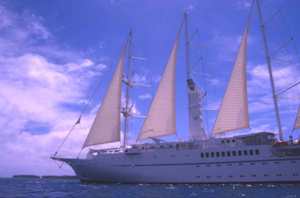 WE HAVE JUST ARRIVED IN ISTANBUL FROM A MARVELLOUS MEDITERRANEAN CRUISE ON THE ‘WINDSTAR’, A BOUTIQUE MOTORISED SAILING SHIP THAT HAS BROUGHT US HERE FROM ATHENS VIA THE GREEK ISLANDS AND THE TURKISH COAST. BUT RATHER THAN FLY STRAIGHT HOME, AND THERE ARE MANY FLIGHTS TO AND FROM TURKEY, WE HAVE DECIDED TO STAY IN THIS FASCINATING, HISTORY LADEN CITY TO EXPLORE ITS DELIGHTS. IT TURNS OUT TO BE A GREAT DECISION.
WE HAVE JUST ARRIVED IN ISTANBUL FROM A MARVELLOUS MEDITERRANEAN CRUISE ON THE ‘WINDSTAR’, A BOUTIQUE MOTORISED SAILING SHIP THAT HAS BROUGHT US HERE FROM ATHENS VIA THE GREEK ISLANDS AND THE TURKISH COAST. BUT RATHER THAN FLY STRAIGHT HOME, AND THERE ARE MANY FLIGHTS TO AND FROM TURKEY, WE HAVE DECIDED TO STAY IN THIS FASCINATING, HISTORY LADEN CITY TO EXPLORE ITS DELIGHTS. IT TURNS OUT TO BE A GREAT DECISION.
Istanbul harbour! It is one of the great harbours of the world and has seen history made on many occasions. Today it is one of the most important – and beautiful – maritime centres on earth. And we are here on one of the most fascinating ships imaginable, as Istanbul is the start and finish for the Mediterranean cruises of the Windstar cruiseline, whose ships are one of my special favourites.
If you are a romantic, like small boutique ships, where you are not just treated as a passenger computer number, and love the idea of sailing to small ports that large ships cannot access, then Windstar is custom-designed for you. This time our cruise has taken us to this city, and we have decided to explore it in depth before going home. It was the best possible decision.
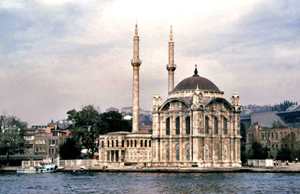 Istanbul is a fascinating mix of East-Meets-West cultures where every nook and cranny could be the setting for a novel by John LeCarre or Len Deighton. Sunset is this city's moment of magic and our concierge has recommended a ferry trip across the limpid waters of the Bosphorus. Sitting on the outside deck of one of the myriad ferries that ply the Bosphorus and the Golden Horn, I watch the sky turn from blue to mauve and then to fiery-red.
Istanbul is a fascinating mix of East-Meets-West cultures where every nook and cranny could be the setting for a novel by John LeCarre or Len Deighton. Sunset is this city's moment of magic and our concierge has recommended a ferry trip across the limpid waters of the Bosphorus. Sitting on the outside deck of one of the myriad ferries that ply the Bosphorus and the Golden Horn, I watch the sky turn from blue to mauve and then to fiery-red.
The water becomes liquid gold and all I can hear is the burble of two families chatting nearby, while in the distance the loudspeakers on a minaret call the devout to prayer. Buildings on the low horizon become a line of purple silhouettes and the sun, dipping over the city in its nightly farewell, kisses the domes and minarets goodnight and then disappears behind the hills.
On the other side of the gangway, two young Turkish girls look as if they are on their way home from the office. One is fair-haired and the other brunette and both are wearing modern, Western-style outfits. They would not seem out of place in the main business streets of Frankfurt, Rome, Paris, Vienna or Athens.
As our ferry moves further north-west, pass by suburb after suburb of old, traditional wooden Turkish houses. A few, their paint peeling, are very run-down. Others have been recently restored and look comfortable – and expensive. In front of some, speedboats costing a minor King's ransom bob at anchor.
I look at the coastline I cannot help thinking that if one wanted to give a Turkish Architectural Historian an impossible task, one would ask him for the most typical example of that country's architecture. For throughout its history Turkey has truly been at the crossroads of some of the world's most important civilisations -- invaded and settled by Hittites, Phrygians, ancient Greeks, ancient Romans, Persians, Syrians, Byzantines, Huns, and finally the Seljuks, Ottomans and their successors, today's secular Turks. Each civilisation has left its footprint on the architectural landscape of the country.
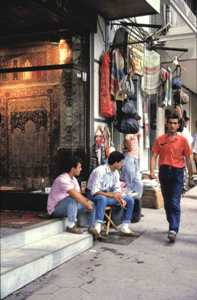 On my way to the Grand Bazaar the next morning I walk through the Old Town. Before reaching that marvellous covered market I stroll along Nuruosmaniye Cad, a street where one can find some of the best carpets in the world. Arguably the very finest of these are the Hereke carpets, so finely knotted with double knots that legend has it that only virgins under the age of 14 can produce such exquisite work. At least that is the story bandied about by the carpet sellers who must be the world's finest salesmen. Each one greets me as I pass, with an invitation to "Just take a look, sir".
On my way to the Grand Bazaar the next morning I walk through the Old Town. Before reaching that marvellous covered market I stroll along Nuruosmaniye Cad, a street where one can find some of the best carpets in the world. Arguably the very finest of these are the Hereke carpets, so finely knotted with double knots that legend has it that only virgins under the age of 14 can produce such exquisite work. At least that is the story bandied about by the carpet sellers who must be the world's finest salesmen. Each one greets me as I pass, with an invitation to "Just take a look, sir".
As we near the Grand Bazaar, youths scurry by with huge parcels of merchandise balanced on heads or shoulders. There are old men with Oriental eyes and weather-beaten skin, wearing sheepskin jackets and fur-trimmed hats in the fashion of their homeland in far-off Turkistan. There are German tourists with big hands, big heads, big bodies and big cameras, and small, gold-toothed Japanese with even bigger cameras and quizzical smiles. Arabs in flowing white galabeyahs stand out from dark-skinned Kurds that hail from the region near the Iraqi border.
In the artificial light of the Bazaar never-ending lines of small stores offer an incredible variety to tempt shoppers. Leather jackets in all colours to fit everyone from the anorexic to the grossly overweight, Turkish pottery decorated with wonderful Islamic calligraphy, tribal rugs and carpets from faraway villages, touristy harem shoes and red fezzes from bygone eras, beautiful hand-beaten silver at a fraction of the price one would pay in Paris, London or New York, traditional Turkish dresses in stunning colours and with elaborate embroidery, finely-etched brass trays, lamps and hubbly-bubblies, and cleverly-lit windows laden with the biggest concentration of gold this side of Fort Knox.
They have earrings from the simplest to the most intricate designs, row after row of bangles in all sizes, necklaces that would gladden the heart of even the most jaded recipient. If you can imagine an Aladdin's cave of goodies, it could not possibly compete with the real-life treasures of the Grand Bazaar.
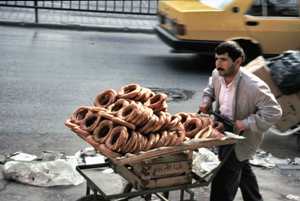 Each shopkeeper is a superb salesman and has his pitch off in English, French, German, Japanese and Spanish. He eyes each passer-by, computes the country of origin and goes into his pitch in the appropriate language. If one says 'No', or 'I'm just looking', he accepts this and is never-the-less friendly and helpful, considering the visit an opportunity to sharpen his language skills rather than cursing the non-customer as a lost sale and time wasted.
Each shopkeeper is a superb salesman and has his pitch off in English, French, German, Japanese and Spanish. He eyes each passer-by, computes the country of origin and goes into his pitch in the appropriate language. If one says 'No', or 'I'm just looking', he accepts this and is never-the-less friendly and helpful, considering the visit an opportunity to sharpen his language skills rather than cursing the non-customer as a lost sale and time wasted.
What can one say about Istanbul's magnificent mosques without constantly breaking into the superlative? The earlier ones, as represented by St. Sophia, were Christian Churches later converted to mosques. But when St.
Sophia was built in 325 AD and then rebuilt after being destroyed by fire in 537 AD, it was arguably the most sophisticated and advanced piece of architecture in the Western world. After the Turks conquered Constantinople in 1453 it was turned into a mosque and used as such until 1935 when Ataturk made it into a museum. As I stand inside this magnificent building, I try to imagine what it must have been like to construct such an architectural marvel with 15th Century limitations on tools, labour and technology. What dramas must have been played out here during this building's heyday!
The Blue Mosque, known in Turkish as the Sultan Ahmet Camii, took its name from 21,043 ceramic tiles that grace the interior. It, again, was designed to upstage the wonderful architecture of the Western cathedrals, and the sheer logistics of construction of this mosque also boggle the mind.
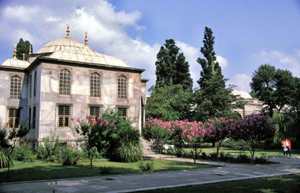 The next day I decide to head for Topkapi. Years ago my imagination had been fired by the brilliant movie of the same name, the plot of which centred around the theft of the most valuable of the Sultan's jewels. But no film could match the reality of the magnificence of the real thing.
The next day I decide to head for Topkapi. Years ago my imagination had been fired by the brilliant movie of the same name, the plot of which centred around the theft of the most valuable of the Sultan's jewels. But no film could match the reality of the magnificence of the real thing.
Away from the frenetic activity and milling crowds of inner Istanbul, I find myself approaching the Topkapi Palace. Here, overlooking three waterways – the Bosphorus, the Golden Horn, and the Mamara – is an island of tranquillity that is now a very special museum. Till the end of World War I this palace was the seat of the Ottomans, a power which at one time was so great as to threaten and influence the destiny of Europe.
For 400 years the decisions made here affected a realm stretching from today's Austria, Italy, Russia and Hungary to Egypt and Araby. For this was the very heart of the Turkish Empire. Founded during the reign of Mehmet, the Conqueror of Constantinople, the Topkapi Palace was subsequently enlarged and embellished by later Ottoman Sultans, its buildings and courtyards eventually stretching over more than 30 acres.
I cross into the Third Courtyard, and enter into the chamber that contains the items attracting most foreign visitors to Topkapi, a display of the jewels of the Ottoman Treasury.
These gems are truly breathtaking! Suspended above the Sultan's throne are a number of huge emeralds, so large that they look somewhat gross and glassy. Yet they are worth a king's ransom. In a protected jewel case is the Topkapi dagger sparkling in the spotlight that enhances its three huge emeralds placed along the handle. Few know that there is a watch hidden under the fourth emerald at the end. In the turban of Sultan Mehmed IV, I see the 86 carat Spoonmaker's diamond, one of the finest gems in the world and surrounded by other flawless stones. A glass case contains a throne made of solid gold and reported to weight more than 250 kilograms.
But what really fires my imagination is the harem, built by Sultan Murat III in the late 16th century and subsequently remodelled by other Sultans. What would life in the harem have been like? The rooms are heavily barred, but have exquisite decor and tiling. Some rooms contain reconstructed scenes showing how they must have looked in their heyday.
Bathrooms are luxurious and the Sultan's Mother's quarters are especially lavish. Our guide explains that, when the Sultan took a concubine she had the right to leave if she chose to do so. I wonder whether this was really so, and what the Sultan's reaction would have been to any serious request to leave.
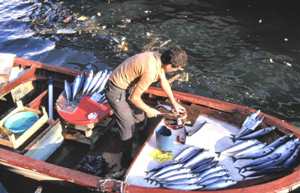 Along the shores of the Bosphorus are suburbs that still contain many 17th and 18th century traditional houses. The ground floor of these is usually stone with colourfully painted and often intricately carved overhanging wooden superstructures. While in Istanbul I am staying at the sumptuous Ciragan Palace Hotel, considered the finest and most elegant establishment of its kind in this city. In its early days it was an Ottoman family Palace. Overlooking the Bosphorus, the building was constructed for the Sultan's family by Garabed Balian in 1835 on the site of a previous palace. In 1855 it was rebuilt as an imposing stone edifice for Sultan Abdulaziz. On November 1909 the palace briefly became the location for Parliament and was later gutted by a fire that only left the building's shell. After years of neglect the facade and remaining building was lovingly restored by the Kempinski hotel group around 1990. It would be difficult for anyone who sees the columned Ciragan Palace facade not to acknowledge the similarity to the Roman library at Ephesus.
Along the shores of the Bosphorus are suburbs that still contain many 17th and 18th century traditional houses. The ground floor of these is usually stone with colourfully painted and often intricately carved overhanging wooden superstructures. While in Istanbul I am staying at the sumptuous Ciragan Palace Hotel, considered the finest and most elegant establishment of its kind in this city. In its early days it was an Ottoman family Palace. Overlooking the Bosphorus, the building was constructed for the Sultan's family by Garabed Balian in 1835 on the site of a previous palace. In 1855 it was rebuilt as an imposing stone edifice for Sultan Abdulaziz. On November 1909 the palace briefly became the location for Parliament and was later gutted by a fire that only left the building's shell. After years of neglect the facade and remaining building was lovingly restored by the Kempinski hotel group around 1990. It would be difficult for anyone who sees the columned Ciragan Palace facade not to acknowledge the similarity to the Roman library at Ephesus.
My head whirrs with images of Istanbul in each of the different time warps that were particularly meaningful to this city. There is so much I've seen and loved, yet there is so much more still to be seen.
Each day, I'm sure will bring new discoveries and new wonders. But be that as it may, Istanbul has captured my heart and my imagination, and I cannot help thinking of the words of Alphonse de Lamartine who said "If one had but a single glance to give the world, one should gaze on Istanbul".
FACT FILE:
Istanbul is at the beginning or end of a large proportion of Mediterranean cruises. Plan for 4-5 days in this city at either end of the cruise. We recommend that you consider our favourite, the Windstar Cruise Line -- www.windstarcruises.com – it has brilliant, hi-tech motorised sailing ships with spacious cabins, yet the ships are small enough to get into small ports that large cruise ships cannot use.
BEST TIME TO GO:
May/June or September/October. Year-end is not cruising season, and July/August can be too hot for comfort.
TAKE:
Loose, comfortable (but stylish where possible) clothes, comfortable shoes, and don’t forget your wide-brimmed hat and sunglasses. Ladies should wear long-sleeved blouses or dresses. Modesty is the norm in clothing, so no minis, shorts or revealing tops, please.
ISTANBUL SHOPPING:
Best buys are Bulgari-quality gold jewellery, outstanding leather gear, sterling silver, and Turkish rugs and carpets. All of these are bargains in Istanbul. It is fine to bargain, but don’t ask for prices unless you are really interested in the product.
![]()
Walter & Cherie Glaser are an international travel-writing team based down under in Melbourne, Australia.
Note: This information was accurate when it was published. Please be sure to confirm all rates and details directly with the businesses in question before making your plans.



